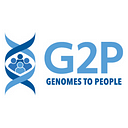From Researcher to Patient: Knowledge is Power
I hope for a future where more people can choose to learn about their genetics and take control of their health.
by Charlene Preys, MS, GC
When I began as a research trainee with the Genomes2People (G2P) research program in 2019, it never crossed my mind that I might end up at the epicenter of preventive genomic medicine as a patient myself. I have had the honor of counseling patients across various clinical specialties as a genetic counseling trainee, and worked in genetics research that empowers individuals to take control over their health based on their genetic findings. Up until a year ago, I thought I was training to become a healthcare provider, not to be a patient.
One year ago, I underwent genetic counseling and testing for hereditary cancer associated with the ATM gene after a family member discovered their own ATM status. You can read about this experience here. The ATM gene is associated with breast, pancreatic, ovarian, and prostate cancers. When someone has a pathogenic variant in the gene, it increases their lifetime risk of developing one of these cancers. For me, it was important to discover my ATM status because of my family’s history of cancer so that I can hopefully prevent a cancer diagnosis or catch one early on.
Upon receiving my ATM status, my risk of developing breast cancer jumped from 12% to 40% and my risk of developing pancreatic cancer increased from <1% to 10% (NCCN Guidelines V1.2023). These percentages within the context of my family history are not just numbers. They can mean life or death. Knowing these percentages used to make me feel nervous, scared, and at times emotional. One year later, these numbers symbolize empowerment — I have knowledge that my aunts did not have when they were diagnosed with cancer.
I can do something about my risk.
When learning to cope with my cancer risk, patient organizations and support groups were vital to my healing process. Two months after learning my ATM status, I joined my first virtual support group on Facebook. I discovered a community of people who were living a story similar to mine, which was healing in and of itself; I found people who understood my grief and fear. I found people who could share their experiences and offer advice.
Six months later I discovered an organization called The Breasties. This organization works to connect cancer survivors, previvors, and thrivers to one another through virtual support groups and local in-person events. Their goal is to uplift the voices of people living with a looming cloud of cancer, share their stories, and build a community. Because of The Breasties, I feel seen. My emotions have been validated, and they have empowered me to see that yes, my risk is scary, but I can do something about it.
As we enter the month of October or “Breast Cancer Awareness Month,” I want to draw attention to patient support organizations that directly benefit those impacted by breast and gyn cancers. We do not need an awareness month — we need action, support, and donations that will directly benefit those affected. In addition to providing community, patient organizations often offer direct monetary support to individuals in need. In a 2015 paper published in The Journal of European Health Economics, authors found that a patient diagnosed with breast cancer can pay anywhere from $103,573 to $376,573 for healthcare costs per year in the United States, compared to those without a breast cancer diagnosis who pay an average of $8,019 per year. These numbers are concerning, particularly where the average income of a person living in the United States is just shy of $75,000 per year. Organizations such as The Breasties connect patients, survivors, and previvors to scholarship and funds to help alleviate the costs associated with treatment and prevention.
I challenge readers to reconsider purchasing a t-shirt with a pink ribbon on it at the store, or a pink lanyard. Consider donating to The Breast Cancer Assistance Fund, Genevivie’s Helping Hands, The Gift of Hope, The Pink Fund, or the Sisters Network Breast Cancer Assistance Fund instead. If monetary support is not within your own reach, connect with these organizations to offer assistance to individuals in other ways! Cooking a meal, taking care of household tasks, or running an errand is just as impactful as a monetary donation.
As I reflect on the last year, I am grateful. My ATM status has given me access to cancer prevention, screening at 25 years young, and an oncologist that I would not have otherwise. Preventive healthcare works. Now, as a patient and genetic counselor, I support the mission of G2P more than ever. Offering whole genome sequencing for individuals without a personal or family medical history of hereditary disease may seem extreme, but our MedSeq and BabySeq studies show that 10–15% of ostensibly healthy people harbor a pathogenic finding that can directly impact the care they receive. We call these medically actionable results, where an individual discovers they have a variant in a gene where preventive screening, or treatment exists. For many reasons, individuals may not want this information, but if we can offer it, why not do so?
I hope for a future where more people can choose to learn about their genetics and take control of their health. I have found comfort and empowerment in my journey and hope that more people can too.
Charlene Preys, MS, GC, has been a Clinical Research Assistant with Genomes2People since 2020.
